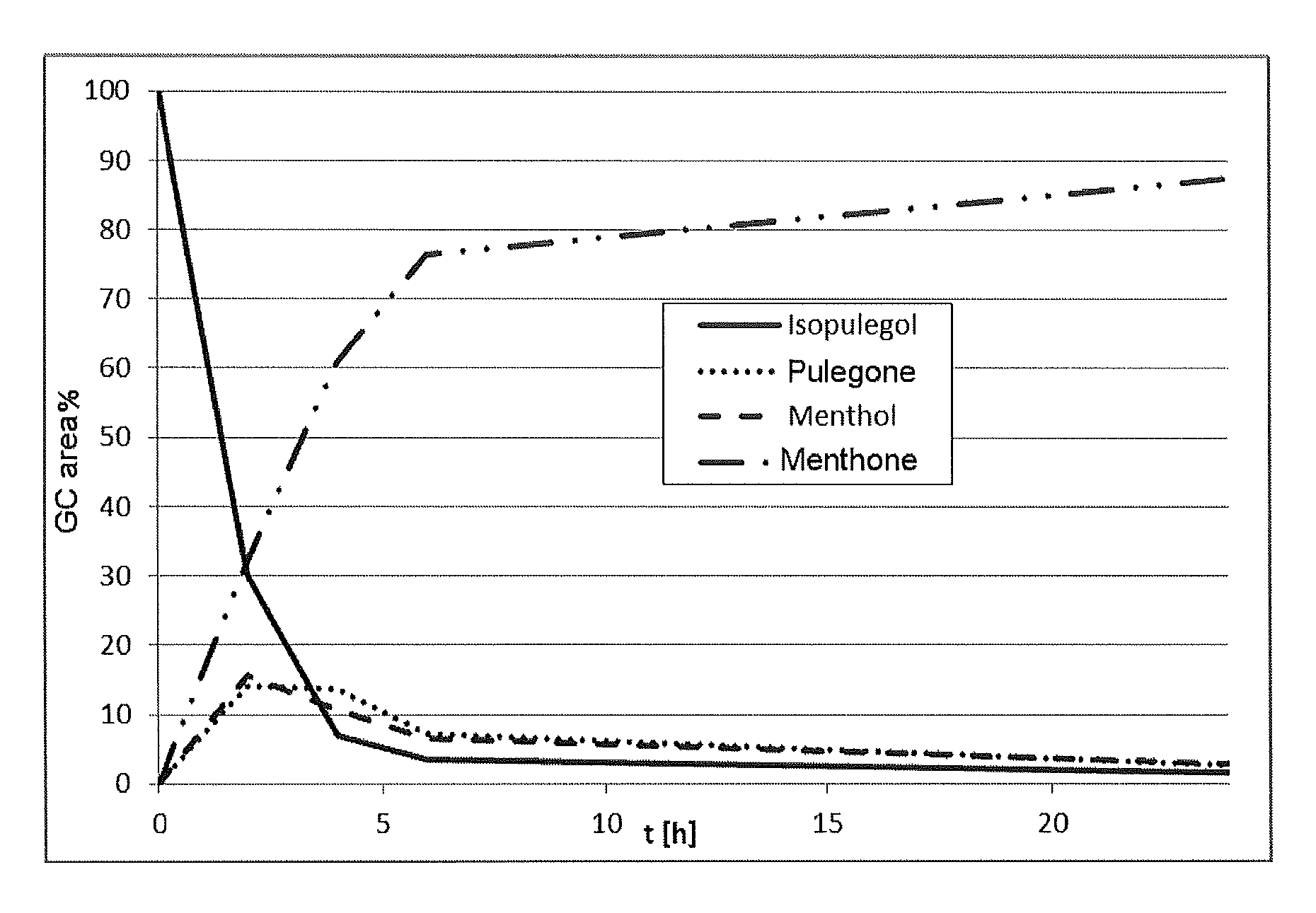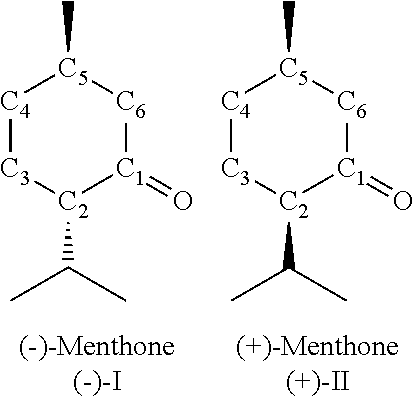Method for preparing menthone from isopulegol
a technology of isopulegol and menthone, which is applied in the preparation of carbonyl compounds, organic chemistry, dehydrogenation, etc., can solve the problems of reducing the availability of dementholized cornmint oil, reducing the proportion, and cyclical fluctuations leading to price fluctuations, and achieves high yields
- Summary
- Abstract
- Description
- Claims
- Application Information
AI Technical Summary
Benefits of technology
Problems solved by technology
Method used
Image
Examples
preparation example 1
[0099]Under inert conditions, 202 mg of [Ru(PnOct3)4(H)2], 1.8 g of isopulegol and 10 ml of o-xylene (anhydrous) are weighed out in a glovebox into a 50 ml two-necked flask. The reaction mixture is then stirred at normal pressure for 12 hours under reflux cooling at an oil bath temperature of 133° C. After the reaction, the conversion and the yield of menthone (sum of isomers) is determined by gas chromatography (Area %). The conversion of isopulegol is 60.5% with a selectivity for menthone (isomer mixture of 66.2% (−)-menthone, 33.8% (+)-isomenthone) of 47.3%. Selectivity for the secondary components: menthol 31.6%, isopulegone 14.9%, total selectivity (menthone+menthol+isopulegone) 93.8%.
preparation example 2
[0100]Under inert conditions, 116 mg of [Ru(PnBu3)4(H)2], 54 mg of 1,2-bis(dicyclohexylphosphino)ethane, 1.8 g of isopulegol and 10 ml of o-xylene (anhydrous) are weighed out in a glovebox into a 50 ml two-necked flask. The reaction mixture is then stirred at normal pressure for 12 hours under reflux cooling at an oil bath temperature of 133° C. After the reaction, the conversion and the yield of menthone (sum of isomers) is determined by gas chromatography (Area %). The conversion of isopulegol is 62.9% with a selectivity for menthone (isomer mixture of 61.7% (−)-menthone, 38.3% (+)-isomenthone) of 31.9%. Selectivity for the secondary components: menthol 27.7%, isopulegone 15.5%, total selectivity (menthone+menthol+isopulegone) 75.1%.
preparation example 3
[0101]Under inert conditions, 116 mg of [Ru(PnEt3)4(H)2], 1.8 g of isopulegol and 10 ml of o-xylene (anhydrous) are weighed out in a glovebox into a 50 ml two-necked flask. The reaction mixture is then stirred at normal pressure for 12 hours under reflux cooling at an oil bath temperature of 133° C. After the reaction, the conversion and the yield of menthone (sum of isomers) is determined by gas chromatography (Area %). The conversion of isopulegol is 64.2% with a selectivity for menthone (isomer mixture of 70.0% (−)-menthone, 33.0% (+)-isomenthone) of 45.2%. Selectivity for the secondary components: menthol 30.8%, isopulegone 20.2%, total selectivity (menthone+menthol+isopulegone) 96.2%.
PUM
| Property | Measurement | Unit |
|---|---|---|
| temperature | aaaaa | aaaaa |
| temperatures | aaaaa | aaaaa |
| temperatures | aaaaa | aaaaa |
Abstract
Description
Claims
Application Information
 Login to View More
Login to View More - R&D
- Intellectual Property
- Life Sciences
- Materials
- Tech Scout
- Unparalleled Data Quality
- Higher Quality Content
- 60% Fewer Hallucinations
Browse by: Latest US Patents, China's latest patents, Technical Efficacy Thesaurus, Application Domain, Technology Topic, Popular Technical Reports.
© 2025 PatSnap. All rights reserved.Legal|Privacy policy|Modern Slavery Act Transparency Statement|Sitemap|About US| Contact US: help@patsnap.com



